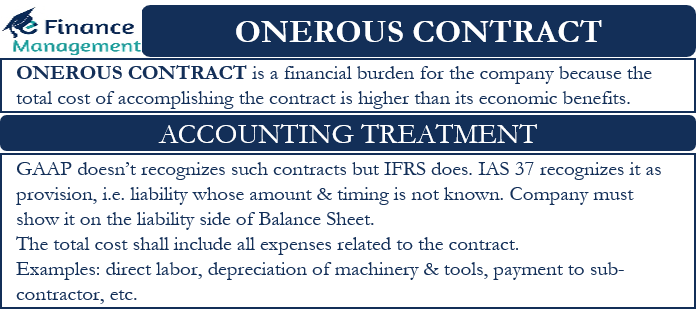An Onerous Contract is, as the word implies, a contract that becomes a financial burden for the company. The total cost of fulfilling this contract or project is higher than the expected economic benefits that the company derives from it.
International Accounting Standard IAS 37 guides on the definition and accounting treatment of onerous contracts. According to IAS 37, it is a contract “in which unavoidable costs of fulfilling contractual obligations exceed economic benefits that are expected.”
Onerous Contract – How to Identify?
To determine such a contract, one has to look at the entire contract and not the individual item performance. A project can be onerous from the outset. Or it can become onerous sometime after the start of the project because external scenarios change. A contract may turn onerous if circumstances lead to an increase in costs or a decrease in its benefits.
It is noteworthy that a project with unfavorable conditions does not necessarily have to be onerous. Instead, it can become onerous if the cost of fulfilling the obligations is higher than the benefit that a company estimates from this contract. Furthermore, a contract that does not deliver the expected result is not onerous. Thus, the contract does not become onerous because of the change in product preference, product obsolescence, adverse demand and supply situation, currency exchange rate changes, taxation, etc. It is burdensome and is termed onerous when the total cost of the project far exceeds its benefit.
Example
Suppose there is a contract in which you are a seller of a commodity. And the market price is less than the cost of buying, mine, or producing that commodity. Another example is when a tenant pays rent for a property but does not use it.
Let’s take another example to understand this contract: Suppose that Company A rents a property for 10 years at $3 million per year for a project. After three years, Company A had to shut down 50% of its operation and property due to the recession. Nevertheless, Company A would have to make the lease payments. And if the costs are higher than the benefits of this project, then it is an onerous contract.
These types of contracts can be very financially burdensome for a company, so it needs to take swift action to offset the costs from its financial statements. Once a company has determined that a contract is onerous, it needs to make quick accounting adjustments. As part of accounting adjustments, the company needs to assess/calculate the expected loss from this contract. And the same needs to be provided for in the accounting books.

Accounting Treatment of Onerous Contract
It is noteworthy that the United States, which follows GAAP (Generally Accepted Accounting Principles), doesn’t recognize such types of contracts. However, IFRS does recognize such contracts.
In accordance with IAS 37, an onerous contract is a “provision,” i.e., it is a liability or a debt where the amount and timing are unknown. One can only estimate a provision on the basis of current obligations.
Under IAS 37, once a company has identified such an agreement, it would have to recognize the obligation as a liability. Also, the company must show the obligation as a liability on its balance sheet. Such treatment of items in a company suggests that it expects a contract to result in a loss.
When it comes to accounting for such contracts, the biggest problem that accountants face is the cost they have to bear in estimating the cost of a contract. IAS 37 was not clear about the cost in the past, which led to different interpretations. Recently, they presented an update. According to the update, the total cost should include all expenses that relate directly to the contract, including the sunk cost. In other words, it is not just the incremental cost but the total cost.
Some examples of such costs are direct labor, direct materials, deprecation of machinery and tools, payment to the subcontractor, and much more. General and administrative costs should not be taken into account unless they can be directly associated with the contract.
Final Words
Onerous contracts are one of the few areas where US GAAP and IFRS differ. So, it is very important for companies operating in the US and other countries to have a full understanding of this concept, and current guidelines require companies to estimate and plan for the expected loss from the contract.
RELATED POSTS
- Contingent Liability – Meaning, Importance, Types And More
- Restrictive Debt Covenants on Term Loan Agreement
- Lump-Sum Contract: Meaning, Advantages, Disadvantages and More
- Unit Price Contract – Meaning, Factors, Advantages, and Disadvantages
- Bankruptcy Cost – It Could Cost You Much More Than You Expect
- Short-term Liabilities

